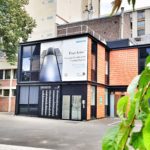Link to Pubmed [PMID] – 32859091
Link to DOI – E15110.3390/jof6030151
J Fungi (Basel) 2020 Aug; 6(3):
Immune inertness of Aspergillusfumigatus conidia is attributed to its surface rodlet-layer made up of RodAp, characterized by eight conserved cysteine residues forming four disulfide bonds. Earlier, we showed that the conserved cysteine residue point (ccrp) mutations result in conidia devoid of the rodlet layer. Here, we extended our study comparing the surface organization and immunoreactivity of conidia carrying ccrp-mutations with the RODA deletion mutant (∆rodA). Western blot analysis using anti-RodAp antibodies indicated the absence of RodAp in the cytoplasm of ccrp-mutant conidia. Immunolabeling revealed differential reactivity to conidial surface glucans, the ccrp-mutant conidia preferentially binding to α-(1,3)-glucan, ∆rodA conidia selectively bound to β-(1,3)-glucan; the parental strain conidia showed negative labeling. However, permeability of ccrp-mutants and ∆rodA was similar to the parental strain conidia. Proteomic analyses of the conidial surface exposed proteins of the ccrp-mutants showed more similarities with the parental strain, but were significantly different from the ∆rodA. Ccrp-mutant conidia were less immunostimulatory compared to ∆rodA conidia. Our data suggest that (i) the conserved cysteine residues are essential for the trafficking of RodAp and the organization of the rodlet layer on the conidial surface, and (ii) targeted point mutation could be an alternative approach to study the role of fungal cell-wall genes in host-fungal interaction.




